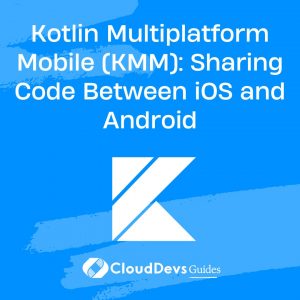Kotlin Multiplatform Mobile (KMM): Sharing Code Between iOS and Android
In today’s fast-paced mobile app development landscape, building applications for both iOS and Android platforms is essential for reaching a wider audience. However, maintaining two separate codebases can be time-consuming and error-prone. This is where Kotlin Multiplatform Mobile (KMM) comes into play. KMM allows developers to write shared code in Kotlin and share it across iOS and Android platforms, reducing development efforts and increasing code maintainability. In this blog post, we will explore the benefits of KMM and learn how it enables seamless code sharing between iOS and Android.
What is Kotlin Multiplatform Mobile (KMM)?
Kotlin Multiplatform Mobile (KMM) is an innovative technology introduced by JetBrains, the creators of Kotlin. It allows developers to write shared code using Kotlin and use it across multiple platforms, including iOS and Android. With KMM, developers can leverage their existing knowledge of Kotlin and share business logic, data models, and utility functions between different platforms. This approach significantly reduces code duplication, enhances code consistency, and improves development efficiency.
Benefits of KMM
- Code Sharing: One of the primary advantages of KMM is the ability to share code between iOS and Android platforms. Developers can write the core business logic, networking code, and data models once in Kotlin and use them seamlessly on both platforms. This eliminates the need for duplicate codebases, reducing development efforts and enabling faster time-to-market.
- Improved Code Quality: Sharing code between platforms promotes code consistency and reduces the chance of introducing bugs or inconsistencies during the development process. Any changes made to the shared codebase automatically propagate to both iOS and Android, ensuring that the applications stay in sync and reducing the possibility of platform-specific issues.
- Productivity Boost: KMM allows developers to work in a unified environment, leveraging the familiar Kotlin language and ecosystem. This eliminates the need to switch between different programming languages and development environments, saving time and increasing productivity. Additionally, with a single codebase, developers can focus on implementing new features and addressing platform-specific concerns, rather than duplicating code or resolving inconsistencies.
Getting Started with KMM
To get started with Kotlin Multiplatform Mobile, you’ll need to set up your development environment and configure your project. Follow the steps below:
- Install Kotlin: Install Kotlin on your machine by downloading it from the official Kotlin website or using a package manager such as SDKMAN! or Homebrew.
- Set up the KMM Plugin: If you’re using IntelliJ IDEA or Android Studio, install the Kotlin Multiplatform Mobile (KMM) plugin. This plugin provides tools and features specific to KMM development, making the process smoother.
- Create a New KMM Project: Create a new KMM project using the project creation wizard in IntelliJ IDEA or Android Studio. Specify the project details, including the platforms you want to target (e.g., Android, iOS).
- Code Sharing: Once your project is set up, you can start sharing code between the platforms. Create shared Kotlin source sets where you can write common code that will be shared across both iOS and Android. These source sets should contain the business logic, data models, and utility functions that are platform-agnostic.
- Platform-Specific Code: While most of the code will be shared, there may be cases where you need to write platform-specific code to handle differences between iOS and Android. KMM provides mechanisms to write platform-specific code blocks that are executed only on the target platform.
Example: Shared Code
Here’s an example of a shared Kotlin function that calculates the square of a number:
kotlin
// SharedCode.kt
expect fun square(number: Int): Int
fun calculateSquare(number: Int): Int {
return square(number)
}
Example: iOS Implementation
In the iOS-specific implementation, you can use the actual keyword to provide the platform-specific implementation of the square function:
kotlin
// iosImplementation.kt
actual fun square(number: Int): Int {
return number * number
}
Example: Android Implementation
In the Android-specific implementation, you can again use the actual keyword to provide the platform-specific implementation of the square function:
kotlin
// androidImplementation.kt
actual fun square(number: Int): Int {
return Math.pow(number.toDouble(), 2.0).toInt()
}
Conclusion
Kotlin Multiplatform Mobile (KMM) is a game-changer when it comes to sharing code between iOS and Android platforms. By leveraging Kotlin’s cross-platform capabilities, KMM simplifies the development process, reduces code duplication, and increases productivity. With KMM, developers can build high-quality applications that run smoothly on both platforms while minimizing the effort required to maintain and update the codebase. If you’re looking to streamline your cross-platform development efforts, give KMM a try and experience the power of seamless code sharing.
Table of Contents









